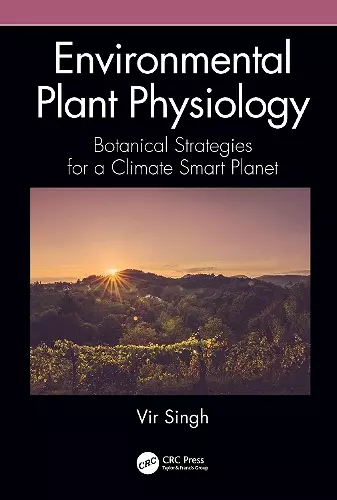Environmental Plant Physiology
Botanical Strategies for a Climate Smart Planet
Format:Hardback
Publisher:Taylor & Francis Ltd
Published:3rd Feb '20
Currently unavailable, and unfortunately no date known when it will be back

Magnitude and quality of life as well as sustainable human progress inescapably depend on the state of our environment. The environment, in essence, is a common resource of all the living organisms in the biosphere as well as a vivacious basis of the evolution of life on Earth. A sustainable future broods over a sustainable environment—an environment encompassing life-originating, life-supporting, and life-sustaining uniqueness. A deteriorating environment haplessly sets in appalling conditions leading to shrinkage of life and a halt in human progress. The current global environment scenario is extremely dismal. Environmental disruptions, largely owing to anthropogenic activities, are steadily leading to awful climate change. Horribly advancing toward mass extinction in the near or distant future and posing a threat to our Living Planet, the unabatedly ongoing climate change, in fact, is an unprecedented issue of human concern about life in the recorded human history.
How to get rid of the environmental mess and resolve environmental issues leading to climate change mitigation is the foremost challenge facing humanity in our times. There are several measures the whole world is resorting to. They are primarily focused on cutting down excessive carbon emissions by means of development of technological alternatives, for example, increasing mechanical efficiencies and ever-more dependence on clean-energy sources. These are of great importance, but there is yet a natural phenomenon that has been, and will unceasingly be, pivotal to maintain climate order of the Earth. For it to phenomenally boost, we need to explore deeper aspects of environmental science. It is the environmental plant physiology that links us with deeper roots of life.
Environmental Plant Physiology: Botanical Strategies for a Climate-Smart Planet attempts to assimilate a relatively new subject that helps us understand the very phenomenon of life that persists in the planet’s environment and depends on, and is influenced by, a specific set of operating environmental factors. It is the subject that helps us understand adaptation mechanisms within a variety of habitats as well as the implications of the alterations of environmental factors on the inhabiting organisms, their populations, and communities. Further, this book can also be of vital importance for policy makers and organizations dealing with climate-related issues and committed to the cause of the earth. This book can be instrumental in formulating strategies that...
Singh (Environmental Science, G. B. Pant University of Agriculture & Technology, India) has written a nine-chapter text summarizing the current and potential/future effects of climate change on plant environmental physiology. He presents a concise, highly distilled summary of major ideas and research for each chapter’s topics ("Environment and Ecosystems: Physiological Basis of Ecology," "Energy Relations," "Nutrient Relations," "Water Relations," "Temperature Relations," "Allelochemical Relations," "High-Altitude Physiology," "Stress Physiology," and "Physiological Effects of Climate Change"). The treatment does not concern only "wild plants" but also looks at agriculture, forestry, and general animal science topics. Each chapter concludes with a brief list of traditional resources for further reading, mostly summary articles and/or textbooks, including a section listing pertinent online resources (websites of reliable organizations and/or government organs). Each chapter contains various summarizing figures or tables, either of the author's own creation or based on ones found in the established literature, representing the relationships between plant growth and environmental factors. These characteristics together make the volume a summary reference for experienced scientists and not necessarily suitable for beginners.
--S. T. Meiers, emerita, Western Illinois University, Choice, 2020 Vol. 58 No. 4
ISBN: 9780367030421
Dimensions: unknown
Weight: 453g
214 pages